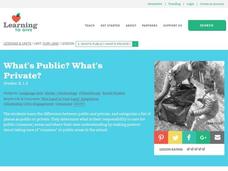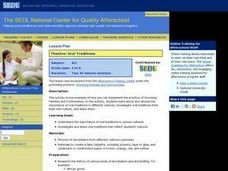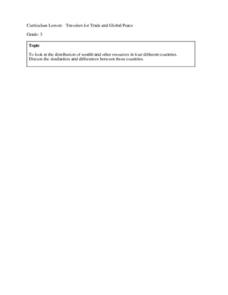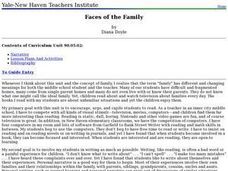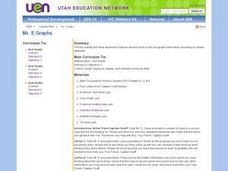Curated OER
Police Athletics: Beyond the Call
Students explore relationships between communities, athletes, and police. In this awareness and education resource instructional activity, students discuss physical activities, benefits of an active lifestyle, and the relationship...
Curated OER
Families and Neighborhoods
Students explore the concept of community. In this community lesson, students explore the cultural flavor of their neighborhoods as they discuss the history of their neighborhoods and draw pictures of their family and a building in their...
Curated OER
What's All the Fuss?
Learners investigate why air quality is important. In this environmental lesson, students research air quality and create an infomercial that explains why air quality is important. Learners use video cameras to record their presentations.
Curated OER
What is a Community?
Students explore the characteristics of their community. In this communities lesson, students read Humphrey the Lost Whale: A True Story and discuss how the community came together to solve a problem. Students identify services within...
Curated OER
What's Public? What's Private?
Students compare and contrast public and private land. In this philanthropy instructional activity, students identify public areas in the school and create posters about taking care of various public places.
Curated OER
Theatre: Oral Traditions
Pupils investigate cultural traditions. In this multi-cultural lesson, students discuss various cultures and research their traditions.
Curated OER
Travelers for Trade and Global Peace
Students explore the resources in other countries. For this communities lesson, students examine characteristics of their community to those of other communities. Students examine Canada, El Salvador, and India and their natural resources.
Curated OER
Communities and Biomes
In this communities and biomes worksheet, students are given twenty terms such as taiga, tundra and permafrost to find in a word search puzzle.
Curated OER
Relationships Among Living Things
For this relationships among living things worksheet, students determine if given statements are true or false. Students correct the false statements making them true. Also, students answer several short questions that relates to...
Curated OER
Taking Notes / Making Conclusions Worksheet
In this worlds of work and play activity, students make observations about home architecture and gardening as they walk through a neighborhood. Students answer 16 questions that require them to take notes and draw conclusions about what...
Curated OER
Relationships Among Living Things
For this living things worksheet, students review terms and concepts about the different relationships between living things. This worksheet has 7 true or false and 5 short answer questions.
Curated OER
Communities
In this communities worksheet, students answer six questions true or false concerning different types of communities and read eight clues to identify eighty different community helpers.
Curated OER
Community Culture Trunk
Second graders examine the similiarities and differences between the various cultures represented in their class. After being read a story about immigration, they identify things they would have to bring with them if they were moving to...
Curated OER
Faces of the Family
Pupils and teachers share their individual concept of families to begin the lesson. As they read different pieces of literature, they keep a journal of the activities and problems each main character gets into. To end the lesson, they...
Curated OER
Math: Mr. E Graphs
Second graders role-play as members of the "Math Graph Detective Academy" and assist in solving a mysteries. Once they have watched a "top secret" video, they sort objects according to traits into five categories. Throughout five...
Curated OER
Where Do You Live?
Second graders study and compare rural, suburban, and urban communities. They play a board game, read books about communities, and complete several other activities regarding the different types of communities. Several extension and...
Curated OER
Signs of Our Times
Students view photographs of the signs and symbols in their local community. As a class, they note the reason for the signs and write the words on the board. Individually, they complete a worksheet in which they match the symbols with...
Curated OER
Neighborhood and Community
Learners research the history of North Logan, Utah. Using photographs, they identify the similiarties and differences between the past and today. They locate their home on a large map discuss ways in which different groups and...
Curated OER
Like A Good Neighbor
Second graders discuss the characteristics that make a neighborhood. As a class, they create a KWL chart assessing their knowledge about neighborhoods. Students develop a list of rights and responsibilities of good neighbors and...
Curated OER
Comparing Edible Communities
Middle schoolers explore the components of a community by creating analogies between aspects of a community and ingredients within a recipe. They view and discuss pictures, write analogies, and generate a product from a recipe.
Curated OER
Community Journals
Students visit a multimedia online journal as a model for their research and journal about their own communities. They examine writing for themselves and writing for an audience as they study the community and present it in more than one...
Curated OER
From Crowded Classrooms To Broken Streetlights: Exploring Ways To Effect Change in Our Communities
Students discuss issues of concern to their communities and explore the variety of avenues available for concerned community members to address these issues and effect change.
Curated OER
Social Studies Word Cards
In this social studies worksheet, students cut apart 50 word cards. All have words which pertain to citizenship and living in a community. There are no definitions provided.
Curated OER
Community Connections
Eighth graders with a number of disabilities visit people and places in their community while using digital cameras to record their visits. They take digital pictures which they include in books, posters, and other publications which...






